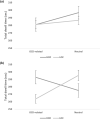Increased attention allocation to stimuli reflecting end-states of compulsive behaviors among obsessive compulsive individuals
- PMID: 37500711
- PMCID: PMC10374647
- DOI: 10.1038/s41598-023-39459-x
Increased attention allocation to stimuli reflecting end-states of compulsive behaviors among obsessive compulsive individuals
Abstract
Attentional research in OCD has focused solely on threat stimuli, assumed to provoke related obsessions and ensuing compulsions. OCD-related stimuli depicting the completion of compulsive acts ("end-states") have yet to be examined. Past research also neglected to explore the reliability of tasks used. Here, attention allocation to both stimuli types was examined. Participants with high (HOC) and low (LOC) levels of obsessive-compulsive symptoms freely viewed three blocks of 30 two-by-two picture matrices, each including two OCD-related (cleaning\checking\ordering) and two neutral pictures, presented for eight seconds, while their gaze was recorded. Participants completed two task versions - one with traditional threat stimuli and one with novel stimuli signaling compulsions end-states. Only the end-state version yielded significant results, showing that HOC participants, compared to LOC participants, spent significantly more time fixating on OCD-related stimuli. Results remained significant after controlling for anxiety, stress, and depression. Task reliability was high. OCD-related stimuli signaling end-states of compulsive behavior should be incorporated in attentional research in OCD.
© 2023. The Author(s).
Conflict of interest statement
The authors declare no competing interests.
Figures


Similar articles
-
Obsessive-Compulsive Symptoms in Obsessive-Compulsive Disorder and in Generalized Anxiety Disorder: Occurrence and Correlations.J Psychiatr Pract. 2020 Mar;26(2):101-119. doi: 10.1097/PRA.0000000000000451. J Psychiatr Pract. 2020. PMID: 32134883
-
Obsessions and Compulsions in Postpartum Women Without Obsessive Compulsive Disorder.J Womens Health (Larchmt). 2015 Oct;24(10):825-30. doi: 10.1089/jwh.2014.5063. Epub 2015 Jun 29. J Womens Health (Larchmt). 2015. PMID: 26121364
-
Clinical subtypes of obsessive-compulsive disorder based on the presence of checking and washing compulsions.Braz J Psychiatry. 2005 Sep;27(3):201-7. doi: 10.1590/s1516-44462005000300008. Epub 2005 Oct 4. Braz J Psychiatry. 2005. PMID: 16224607
-
Obsessions and compulsions in the lab: A meta-analysis of procedures to induce symptoms of obsessive-compulsive disorder.Clin Psychol Rev. 2017 Mar;52:137-147. doi: 10.1016/j.cpr.2017.01.001. Epub 2017 Jan 16. Clin Psychol Rev. 2017. PMID: 28119197 Review.
-
[Current and emerging features of obsessive-compulsive disorder--trends for the revision of DSM-5].Seishin Shinkeigaku Zasshi. 2012;114(9):1023-30. Seishin Shinkeigaku Zasshi. 2012. PMID: 23198591 Review. Japanese.
Cited by
-
Identifying emotional components of event-related potentials in the brain functioning of individuals with contamination obsessions and comparison with healthy control group.Front Psychol. 2023 Nov 16;14:1240493. doi: 10.3389/fpsyg.2023.1240493. eCollection 2023. Front Psychol. 2023. PMID: 38046120 Free PMC article.
References
-
- Association, A. P. & Association, A. P. Diagnostic and statistical manual of mental disorders: DSM-5 (2013).
-
- Mataix-Cols D, Vallejo J, Sanchez-Turet M. The cut-off point in sub-clinical obsessive-compulsive research. Behav. Cogn. Psychother. 2000;28:225–233. doi: 10.1017/S1352465800003039. - DOI
MeSH terms
LinkOut - more resources
Full Text Sources
Medical
Miscellaneous

